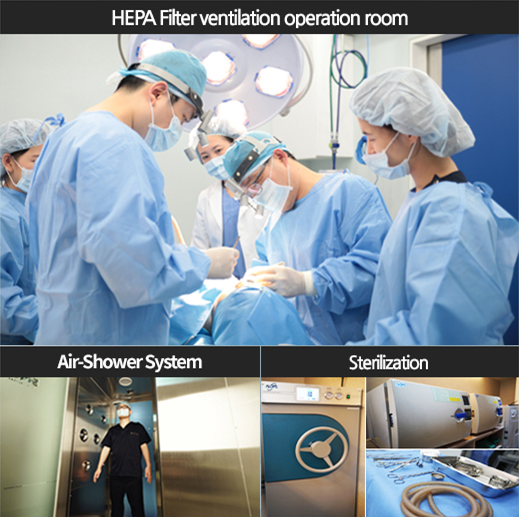GNG
Revision Rhinoplasty
Nose types are placed into categories to improve
functional/aesthetic aspects for greater satisfaction and results
What is GNG Revision Rhinoplasty?
Revision surgery is considered when the first rhinoplasty procedure wasn’t satisfactory or there is a problem with the implant that was inserted. At GNG, nose types are divided into categories to provide customized surgery plans for each patient to achieve greater satisfaction and results.
Revision surgery is more complex than primary surgery so it is vital that you get revision rhinoplasty done at a hospital with ENT specialists who have vast experience in rhinoplasty and knowledge in nasal structure to avoid another unsuccessful surgery

Nose types are divided into categories and procedures are then performed.
Even complex and difficult cases are doable.
Problem occurred in
exterior of nose
Shifted, noticeable implant, recurrence of crooked, humped nose and unsatisfying nose line
A case where reconstruction
rhinoplasty is required.
Change of nasal structure, shape, inflammation/necrosis, protruding implant, and dented/protruding columella.
Recurrence of nasal congestion
despite of previous functional surgery
A case where septoplasty didn’t improve functionality of the nose or occurrence of complication
Adventage of GNG Revision Rhinoplasty
Point 1 Cause of rhinoplasty failure is analyzed prior to surgery!
GNG analyzes the cause of the failed primary surgery and conducts a surgery plan according to our uniquely categorized surgery and nose types. For this reason, we are able to deliver an increased level of satisfaction in revision surgeries.
Prior to surgery
Precise cause of rhinoplasty failure is
identified and diagnosed
-
Individual needs are comprehended
Individual’s opinion and speculation of cause of failure is examined.

-
Medical opinion
Pre-diagnosis is made using high-tech 3D CT scan,
electronic nasal endoscope and also medical opinion from specialist.
Customized surgery plan
Instance of external nasal shape gone wrong
Shifted implant
-
Cause
Failure to create proper design of implant that matches with the shape and position of of nasal tip.
Implant was not firmly fastened with fascia
Shift of implant causes crooked nose or cause inflammation.
-
Surgery method
Implant is redesigned and repositioned to adhere with fascia
If inflammation exists, artificial implant is removed and
More info for No-plant Rhinoplasty ▶
donated/own cartilage is used as replacement.
Noticeable implant
-
Cause
Nasal bridge was projected too much without considering
overall facial balance.Implant was inserted into nose with wide nasal bridge without osteotomy.
If synthetic material is used for the tip as well.
-
Surgery method
Change and customization of implant design that considers
overall facial balance.For broad nasal bridge, osteotomy is performed to narrow the nasal bridge and implant is inserted.
Use own/donated cartilage for nasal tip.
Deviated nose
-
Cause
Change of septum shape.
Implant was inserted without fixing the the cause that caused crooked nose.
-
Surgery method
Implant is removed and crooked nose correction is done
More info for Deviated nose rhinoplasty ▶
during the surgery just like the primary surgery.
Hump nose
-
Cause
Cartilage that was sanded down to remove the hump, but it regrew once more.
Primary surgery did minimal correction of hooked nose correction.
-
Surgery method
Depending on the development of hump, either nasal tip is projected or hump is removed just as primary surgery.
More info for Hump nose rhinoplasty ▶
Absorption of fascia
-
cause
Fascia that covered hump nose was absorbed, making hump more prominent.
-
Surgery method
If absorption is the cause of problem, implant must be exchanged.
Other dissatisfaction
-
Cause
Dissatisfied with nose line
The nasal bridge is too high or low and the nasal tip line is not beautiful etc
Surgery method
Existing implant is removed and ideal nose line is recreated for individual.
-

If Reconstructive Rhinoplasty is required
-
Cause
Change of nasal structure/nostrils/shape, inflammation/necrosis, implant protruding out of skin, dented/protruded columella
-
Surgery method
As reconstructive surgery is different from average rhinoplasty, there is high chance of problems recurring if same surgery method is used. In this instance, reconstructive surgery is required.
Reconstructive surgery is possible without 6 months of wait
GNG Reconstruction Rhinoplasty
Click for more
Nasal congestion recurred after nasal decongestion rhinoplasty
-
Cause
No improvement after Septoplasty and Nasal Valve Reconstruction or it developed complication.
-
Surgery method
High tech equipment is used to precisely identify the problem and plan surgery method to prevent recurrence of congestion.
Problem is identified and corrected through precise analysis
GNG revision surgery for nasal congestion
Click for more
-

Before revision
After
-

Before revision
After
Care after surgery
Provision of after care treatments to
enable quick recovery after specialized surgery
-
Hyperbaric Oxygen & Infrared Ray treatments
Prevent recurrence of inflammation after revision rhinoplasty!
For revision cases where skin tissue is already damaged and stretched, there’s higher chance of inflammation due to blood circulation problem. At GNG, we provide patients with Hyperbaric Oxygen & Infrared Ray therapy to boost blood circulation to dramatically lessen chance of inflammation.

-
Nutriment IV drip
Increase immunity for quicker recovery!
This concoction of concentrated nutrients nucleic acid found in antioxidant which is known to boost your metabolism and stabilize nutrients to increase your immunity.
As it is directly supplied through your vein, it allows quick recovery.
Point 2 Prevent nasal congestion after revision surgery
Sometimes patients experience nasal congestion after primary surgery which makes them hesitate for revision surgery.
However at GNG, we prevent nasal congestion from occurring to ensure higher degree of completion in functional aspect of the nose.
Cause of congestion
after primary rhinoplasty
01
Temporary swelling of
mucous membrane
post operation
02
Septum is weakened
and crooked from
cartilage extraction
03
Extended septum is
thickened
04
Alar cartilage is weakened
and narrowed
Nasal congestion prevention measures taken only at GNG
-

Nasal congestion is treated at
the same time using precise
examinations. -

ENT endoscope test is performed
during operation to prevent nasal congestion. -

Minimum extraction of
septum cartilage using GNG’s technical skill
Point 3 Having performed over 6,091 revision rhinoplasty operations, GNG Hospital is considered top of the class in the industry.
As revision rhinoplasty is a complex surgery, it is advisable to select the hospital with
vast experience in performing rhinoplasty procedures with good results.
GNG Hospital is considered the class of the industry nationally
as we carry out safe procedures with satisfying results.
-
Get your surgery with reassurance!
Usage of the HEPA filter ventilation system in all operation rooms.
What is a HEPA filter ventilated operation room?
The air outside the operating room is filtered cleanly by the HEPA filter and circulated inside.
Because air is circulated by providing clean air through a positive pressure system, you don’t need to worry about infection caused by air pollution thus having surgery with confidence.
Also, there is an air-shower system that shakes off contaminated dust before entering the operating room. We strive to do our best in preventing infection through sterilization and thorough infection control of all medical devices.
Be rest assured! GNG’s operation rooms are meticulously clean.
-





